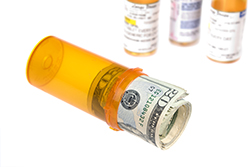 Blog updated on March 27, 2017 to reflect most recent data.
Blog updated on March 27, 2017 to reflect most recent data.
According to Express Scripts’ 2016 Drug Trend Report, national prescription drug spending increased just 3.8% in 2016, down from 5.2% in 2015 and a whopping 13.1% in 2014. This may very well come as a surprise to those who have witnessed prescription drug claims jump from 18-20% of their total medical and Rx spend to 35% and greater. Don't worry, you're not alone!
What Is Driving The Increase?
There are a few key factors driving this increase in drug spending:
Focus On Specialty Medications
Drug manufacturers are changing their business models, shifting away from research and development of drugs for common conditions and moving toward niche drugs and specialty medications to treat a smaller subset of patients with cancer, genetic disorders, and rare diseases. Increased generic drug competition, expired patent protections, and a slowed pipeline for these broad-reaching drugs precipitated this change as drug manufacturers see a golden opportunity in developing highly-specialized drugs that can be sold at an exorbitant price tag with a 12-year patent protected period.
Depending on which study you read, there was $99 billion in specialty spend in 2015 and projections of $191 billion to $402 billion in 2020. In 2015, specialty drugs accounted for 32% of Rx spend and are projected to be 47% in 2020. Yet another study states there are nearly 700 specialty drugs - with approximately 300 drugs in development for oncology, with next closest disease state being around 50 - in the pipeline and spending is expected to be $1.7 trillion in 2030!!
Certain drugs are being priced as orphan drugs even though the disease population far exceeds the 200,000 threshold the U.S. Food and Drug Administration uses to classify as such. Harvoni® (ledipasvir/sofosbuvir) would be one example. Harvoni® is intended for patients with genotype 1 of the hepatitis C virus, a disease affecting an estimated 3 million patients in the U.S. One Harvoni® tablet is offered at the wholesale price of approximately $1,125 per tablet or $94,500 for a 3-month treatment. But yet a 3-month supply of this same medication can be purchased in India for about $1,000.
Other specialty drugs will be priced similarly to reward the costs of research and development. Payors and plan administrators should be wary of the bankrupting potential that accompanies many of these drug prices. Be proactive in taking measures to mitigate the inherent risk that employer-sponsored plans are facing.
Higher Costs For Compounded Drugs
Compounded drugs are used when commercial products or particular dosage forms are unavailable. Pharmacists customize unique dosage forms for patients with specific therapeutic needs. For a variety of reasons, compounded drugs are now the third most expensive therapeutic drug class on a per-member-per-year basis.
Industry practices have made it easier to track the costs of the ingredients, and a 2012 update to the HIPAA standard for pharmacy transactions requires compounded drugs to be billed according to the specific average wholesale price of each ingredient. The prior billing practice rolled up the entire cost under the highest-priced ingredient alone. The result is drug manufacturers increasing the costs of the component ingredients, causing steep cost increases for compounded drugs.
Supply Chain Consolidation
Over the past few years, brand name medications have lost their patent-protected status, resulting in a wave of generic alternatives, creating more competition between manufacturers and price reductions on new generic medications. However, the rate of these price reductions is beginning to slow due to merger and acquisition activity between drug manufacturers. Fewer manufacturers means less competition and increased pricing power for the few remaining manufacturers. By and large, generic alternatives still create cost savings for payors and plan sponsors, but increased consolidation will continue to dig into these savings.
Cost Management Strategies
Partnering with a pharmacy vendor or benefit manager with these cost management capabilities is key in managing your plan’s prescription drug spend.
- Shift Coverage to Pharmacy Benefits – Costs for specialty medications can vary based on where and how they are administered. When providers administer a specialty drug, the expense is billed against the medical benefit and oftentimes includes a drug markup and a provider charge. On the other hand, self-administered drugs bill strictly against the pharmacy benefit at a lower cost. Steering drug coverage towards the pharmacy benefit as mush as possible is one viable strategy to better manage costs.
- Pre-Authorizations – According to PBMI, 90% of plan sponsors require prior-authorization for brand name drugs with less expensive generic substitutes or drugs that are often missed or abused in order to manage the costs under the pharmacy benefit.
- Clinical Care Management Programs – Some PBMs offer programs to coordinate care for patients to create better patient outcomes while ensuring proper drug utilization and drug spend.
- Step Therapy – These programs require patients to try low-cost medications first before “stepping up” to more expensive drugs. The aim is to find the lowest-cost therapeutic drug solution.
- Limit Drug Dispensing – Rather than allowing a full 30 or 90-day supply for specialty drugs, some PBMs specify dispensing limits of 1 or 2-weeks for high cost drugs to avoid potential waste.
- Pharmacy Benefit Plan Design – Moving to a 4-tier pharmacy benefit design with appropriately priced copayments, minimums, maximums, and coinsurance percentages can drive down drug utilization and encourage the use of generic alternatives.
- PBM Leverage – Engage alternative PBM’s in discussion to determine what alternatives exist in the marketplace. Just because the PBM may be the largest in the industry, doesn’t mean they are the most competitive. Don’t underestimate the value of leverage when considering alternatives to your current pharmacy arrangements…similar to other health and welfare coverages.




